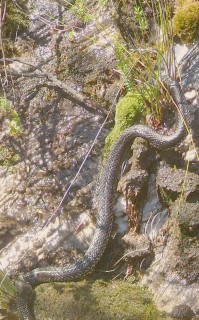
Tiger Snake in Tasmania
|
Flora & Fauna Areas Australia Flora/Fauna Related Pages Australia HomeAustralia Newsletters Australia Cruising |
Australia Fauna
| Where to find wildlife in Australia. Just look around. It's everywhere. Koalas live on the east and south coast forests, high in the Eucalyptus trees. If you see a Koala Crossing sign on the highway, that's a sure give-away. Wild roos (and wallabies) frequent parks and grasslands in the evenings and early mornings. Snakes are harder to find, and if an Aussie sees it first, it's likely to be killed. Insects, birds and bugs, plus lizards, geckos and skinks abound. Your guide book will list many nature parks (in addition to the famous Australia Zoo) throughout the country. A drive in the outback or national parks will yield the best wildlife if you camp and let the wombats, wallaroos and other creatures come to you. |
This page highlights some of the unique insects, snakes and lizards of Australia. For mammals (like kangaroos!) see the Australia Mammals page. Interested in avi-fauna? See our Australia Birds 1 and Australia Birds 2 pages.
In Australian, the native wildlife hops, crawls, lurks and flies around you daily. You needn't go to parks to see kangaroos, emus, possums, parrots, spiders or lizards. Some animals are harder to locate than others: koalas live in the wild throughout the eastern coastal forests but are difficult to see high in their gum (eucalyptus) trees. Snakes are everywhere, but are afraid of humans (for the most part) and are elusive. The lovely energetic foraging platypus is found in many streams but prefers to hide in its burrow by day. Insects abound. Australia is a naturalist's dream.
That being said, campgrounds in national and regional parks are great places to see wildlife. There are many wildlife parks (a step up from zoos) where you can see some of the more elusive animals. All of the photos on these pages were taken in the wild unless otherwise noted. Go to our Australian Mammals page to learn more about the kangaroos, wombats, wallabies, koalas, dingos, possums and more. We photographed too many birds to limit them to just one page, so we've split them into two pages: Australian Birds 1 and Australian Birds 2.
 Tiger Snake in Tasmania |
REPTILES: Australia has over 700 species of reptiles, more in the warm north than the cooler south, and is famous, or infamous, for being home to more than 3/4(!) of the world's poisonous snakes. Luckily, most of these are shy creatures and avoid contact with humans. In addition to snakes, there are many species of skinks, geckos, turtles, the salt and freshwater crocodiles, and lizards.
Friends on the yacht Zen got shots of this Tiger Snake in Tasmania. About 2 meters (6.5 feet) long, the tiger snakes of Australia prefer cool swamps and woodlands. They feed on birds, fish, frogs and small reptiles. Male tiger snakes engage in a ritual wrestling match. The tiger snakes are born live, each female producing from 15 to 80 young! On the right the snake is hunting over rocks and through bushes. The other shot of the same animal shows it in a cool lake where it hunts for fish. Tiger snakes are active in day, and when they're threatened they hiss loudly, and raise their head and fore body off the ground, flattening it. They're saying "Keep away!" Good idea. The venom of the tiger snake is potentially fatal to humans.
 A Tiger Snake swims for its supper in a Tasmanian lake. Photo: Yacht Zen |
Top Level: Home | Destinations | Cruising Info | Underwater | Boat Guests | Ocelot | Sue | Jon | Amanda | Chris | Site Map | Make a Comment
|
If our information is useful, you can help by making a donation |
Copyright © 2000‑ Contact: Jon and Sue Hacking -- HackingFamily.com, svOcelot.com. All rights reserved.